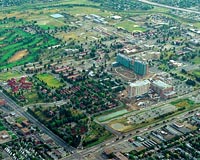 |
Sacramento CA (SPX) Sep 04, 2009 New research shows that climate change in California will make power plants, transmission lines and other portions of the state's energy infrastructure vulnerable to flooding, fires and other disasters, according to leading scientists from the Lawrence Berkeley National Laboratory. This research and other new work on greenhouse gas emissions in California and around the world will be presented at the Sixth Annual Climate Change Symposium in Sacramento next week. The conference will be held September 8 to 10 at the Sacramento Convention Center and is sponsored by the California Energy Commission, the California Environmental Protection Agency and the California Resources Agency. Scientists from Berkeley Lab's Environmental Energy Technologies Division will make presentations on three aspects of the dangers to California's energy infrastructure from increasing temperatures, rising sea levels and changing precipitation due to climate change. Other scientists will present work on a variety of topics, ranging from research showing that methane and nitrous oxide emissions are even greater than currently estimated to research on soot emissions from inefficient stoves in developing countries. A research team led by Jayant Sathaye, with Larry Dale, Andre Frossard Pereira de Lucena and Peter Larsen, is estimating the impact of temperature, precipitation, sea level rise and wild fires due to climate change on California's energy infrastructure, which includes power plants, transmission lines, pipelines, gas and oil refineries and storage facilities. Power plants will be affected by flooding, and high temperatures will reduce their generation, requiring more power plants or efficiency improvements. Infrastructure along the coast and in the delta is vulnerable to flooding and inland to forest fires. Their findings are preliminary since work started only two months ago and will continue until next June. Marc Fischer and his colleagues are conducting atmospheric measurements and inverse modeling to quantify non-CO2 greenhouse gas emissions from central California to help develop a state-wide network for verifying GHG emissions reductions mandated by state legislation (AB 32). Their measurements demonstrate that methane (CH4) and nitrous oxide (N2O) mixing ratios in the Bay Area and Central Valley are significantly enhanced relative to air entering California, and their inverse models suggest that actual CH4 and N2O emissions are greater than current inventories estimate. The research will improve the certainty of the emission estimates and separation of different emission sources (industrial, residential, agricultural and transportation). Share This Article With Planet Earth
Related Links Climate Change Symposium
 APG Helps American Cities Go Green
APG Helps American Cities Go GreenAlgona IA (SPX) Sep 04, 2009 Thousands of cities across the country have what it takes right now to turn their community green and put Americans back to work. The opportunity to capitalize on government stimulus funds is short. Local governments are looking to leverage these dollars to reduce their dependency on foreign oil, clean up the environment, stimulate jobs and deliver economic savings. American Power Group ... read more |
|
| The content herein, unless otherwise known to be public domain, are Copyright 1995-2009 - SpaceDaily. AFP and UPI Wire Stories are copyright Agence France-Presse and United Press International. ESA Portal Reports are copyright European Space Agency. All NASA sourced material is public domain. Additional copyrights may apply in whole or part to other bona fide parties. Advertising does not imply endorsement,agreement or approval of any opinions, statements or information provided by SpaceDaily on any Web page published or hosted by SpaceDaily. Privacy Statement |